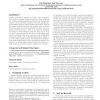Free Online Productivity Tools
i2Speak
i2Symbol
i2OCR
iTex2Img
iWeb2Print
iWeb2Shot
i2Type
iPdf2Split
iPdf2Merge
i2Bopomofo
i2Arabic
i2Style
i2Image
i2PDF
iLatex2Rtf
Sci2ools
DAC
2007
ACM
2007
ACM
Compact State Machines for High Performance Pattern Matching
Pattern matching is essential to a wide range of applications such as network intrusion detection, virus scanning, etc. Pattern matching algorithms normally rely on state machines to detect predefined patterns. Recently, parallel pattern matching engines, based on ASICs, FPGAs or network processors, perform matching with multiple state machines. The state migration in the matching procedure incurs intensive memory accesses. Thus, it is critical to minimize the storage of state machines such that they can be fit in on-chip or other fast memory modules to achieve high-speed pattern matching. This paper proposes novel optimization techniques, namely state re-labeling and memory partition, to reduce state machine storage. The paper also presents architectural designs based on the optimization strategy. We evaluate our design using realistic pattern sets, and the results show state machine memory reduction up to 80.1%. Categories and Subject Descriptors C.3 [Special-purpose and Application...
DAC 2007 | Design Automation | Pattern Matching | Pattern Matching Algorithms | Pattern Matching Engines |
Related Content
| Added | 12 Nov 2009 |
| Updated | 12 Nov 2009 |
| Type | Conference |
| Year | 2007 |
| Where | DAC |
| Authors | Piti Piyachon, Yan Luo |
Comments (0)

